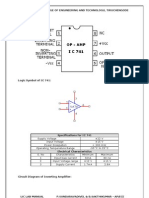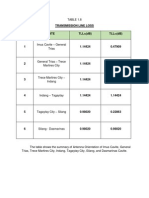0 ratings0% found this document useful (0 votes)
44 viewsDiff Circuit
The document discusses a differentiator circuit constructed using an operational amplifier, resistor, and capacitor. It explains that unlike an integrator circuit, a differentiator circuit is not affected by a DC offset in the input signal since the derivative of a constant is zero. Additionally, it notes that high frequency input signals may saturate the amplifier, so a resistor is placed in series with the capacitor in the input to address this issue. The circuit performs mathematical differentiation, producing an output voltage proportional to the rate of change of the input voltage over time.
Uploaded by
Vam ArmodiaCopyright
© © All Rights Reserved
Available Formats
Download as DOCX, PDF, TXT or read online on Scribd
0 ratings0% found this document useful (0 votes)
44 viewsDiff Circuit
The document discusses a differentiator circuit constructed using an operational amplifier, resistor, and capacitor. It explains that unlike an integrator circuit, a differentiator circuit is not affected by a DC offset in the input signal since the derivative of a constant is zero. Additionally, it notes that high frequency input signals may saturate the amplifier, so a resistor is placed in series with the capacitor in the input to address this issue. The circuit performs mathematical differentiation, producing an output voltage proportional to the rate of change of the input voltage over time.
Uploaded by
Vam ArmodiaCopyright
© © All Rights Reserved
Available Formats
Download as DOCX, PDF, TXT or read online on Scribd
You are on page 1/ 4
CONCLUSION
Differentiator circuit can be constructed as shown using an operational amplifier, a
resistor, and a capacitor. Unlike an ideal integrator circuit where the slightest DC offset
in the input eventually drives the output into saturation, for the differentiator we need
not be concerned about a DC offset in the input since the derivative of a constant is
always zero. Since the output voltage of a differentiator circuit is proportional to the
input frequency, high frequency signals may saturate or cut off the amplifier. For this
reason: a resistor is placed in series with the capacitor in the input.
This circuit performs the mathematical operation of Differentiation, that is it "produces
a voltage output which is directly proportional to the input voltage's rate-of-change with
respect to time. In other words the faster or larger the change to the input voltage
signal, the greater the input current, the greater will be the output voltage change in
response, becoming more of a change in shape.
Rizal Technological University
BONI AVENUE MANDALUYONG CAMPUS
COLLEGE OF ENGINEERING & INDUSTRIAL TECHNOLOGY
ELECTRONICS ENGINEERING 3
Differentiator
Circuit
TEVARMS T. ARMODIA
BS ECE
MH / 12:00P 1:30P
ENGR. ARMANDO HERRERA JR
Differentiator Circuit:
Calculation:
Given:
F = 400Hz
Vin = 1Vp
C1 = 4.7nF
Rf = 22k Ohms
Solution :
= 1
21
= 1
2(400Hz)(4.7 nF)
= .
A =
1 k
=
5.91549
You might also like
- Reference Guide To Useful Electronic Circuits And Circuit Design Techniques - Part 1From EverandReference Guide To Useful Electronic Circuits And Circuit Design Techniques - Part 12.5/5 (3)
- World University of Bangladesh: E #2: S M O U &No ratings yetWorld University of Bangladesh: E #2: S M O U &5 pages
- Integrator and Differentiator Using Op-Amp EX - NO: 2 Date: AimNo ratings yetIntegrator and Differentiator Using Op-Amp EX - NO: 2 Date: Aim7 pages
- Easy(er) Electrical Principles for General Class Ham License (2015-2019)From EverandEasy(er) Electrical Principles for General Class Ham License (2015-2019)5/5 (1)
- Reference Guide To Useful Electronic Circuits And Circuit Design Techniques - Part 2From EverandReference Guide To Useful Electronic Circuits And Circuit Design Techniques - Part 2No ratings yet
- Easy(er) Electrical Principles for Extra Class Ham License (2012-2016)From EverandEasy(er) Electrical Principles for Extra Class Ham License (2012-2016)No ratings yet
- Name of The Experiment: Mathematical Operations Using Op-Amp ObjectiveNo ratings yetName of The Experiment: Mathematical Operations Using Op-Amp Objective2 pages
- STEM: Science, Technology, Engineering and Maths Principles Teachers Pack V10From EverandSTEM: Science, Technology, Engineering and Maths Principles Teachers Pack V10No ratings yet
- 470 39 Solutions-Instructor-Manual SM Chapter-9 PDFNo ratings yet470 39 Solutions-Instructor-Manual SM Chapter-9 PDF3 pages
- Ec 2258 - Linear Integrated Circuits LabNo ratings yetEc 2258 - Linear Integrated Circuits Lab34 pages
- Feynman Lectures Simplified 2C: Electromagnetism: in Relativity & in Dense MatterFrom EverandFeynman Lectures Simplified 2C: Electromagnetism: in Relativity & in Dense MatterNo ratings yet
- 2024 Physical Sciences GR 11 Term 2 Informal Test MemoNo ratings yet2024 Physical Sciences GR 11 Term 2 Informal Test Memo5 pages
- Cavite Province Frequency Plan: General TriasNo ratings yetCavite Province Frequency Plan: General Trias6 pages
- Gprs Architecture: General Packet Radio Service (GPRS)No ratings yetGprs Architecture: General Packet Radio Service (GPRS)6 pages
- OSI Model: A Review: COM47L Engr. Jonai RepublicaNo ratings yetOSI Model: A Review: COM47L Engr. Jonai Republica32 pages
- (2002 Sams) Wireless LANs - 2nd EditionNo ratings yet(2002 Sams) Wireless LANs - 2nd Edition360 pages
- ' Semiconductor Materials and Diodes: Rizal Technological UniversityNo ratings yet' Semiconductor Materials and Diodes: Rizal Technological University8 pages
- Transmission Line Loss HOP Site TLL (DB) TLL (DB) : TX RXNo ratings yetTransmission Line Loss HOP Site TLL (DB) TLL (DB) : TX RX3 pages
- Digital Television (DTV) Is The Transmission of Audio and Video by Digitally Processed andNo ratings yetDigital Television (DTV) Is The Transmission of Audio and Video by Digitally Processed and5 pages
- Mechanical Hazards and Machine SafeguardingNo ratings yetMechanical Hazards and Machine Safeguarding29 pages
- Module 1 - Introduction Engineering Economy: Oikos NomiaNo ratings yetModule 1 - Introduction Engineering Economy: Oikos Nomia21 pages
- Reference Guide To Useful Electronic Circuits And Circuit Design Techniques - Part 1From EverandReference Guide To Useful Electronic Circuits And Circuit Design Techniques - Part 1
- Employability Skills: Brush up Your ElectronicsFrom EverandEmployability Skills: Brush up Your Electronics
- Integrator and Differentiator Using Op-Amp EX - NO: 2 Date: AimIntegrator and Differentiator Using Op-Amp EX - NO: 2 Date: Aim
- Easy(er) Electrical Principles for General Class Ham License (2015-2019)From EverandEasy(er) Electrical Principles for General Class Ham License (2015-2019)
- Reference Guide To Useful Electronic Circuits And Circuit Design Techniques - Part 2From EverandReference Guide To Useful Electronic Circuits And Circuit Design Techniques - Part 2
- Easy(er) Electrical Principles for Extra Class Ham License (2012-2016)From EverandEasy(er) Electrical Principles for Extra Class Ham License (2012-2016)
- Name of The Experiment: Mathematical Operations Using Op-Amp ObjectiveName of The Experiment: Mathematical Operations Using Op-Amp Objective
- STEM: Science, Technology, Engineering and Maths Principles Teachers Pack V10From EverandSTEM: Science, Technology, Engineering and Maths Principles Teachers Pack V10
- 470 39 Solutions-Instructor-Manual SM Chapter-9 PDF470 39 Solutions-Instructor-Manual SM Chapter-9 PDF
- Learn Amateur Radio Electronics on Your SmartphoneFrom EverandLearn Amateur Radio Electronics on Your Smartphone
- Feynman Lectures Simplified 2C: Electromagnetism: in Relativity & in Dense MatterFrom EverandFeynman Lectures Simplified 2C: Electromagnetism: in Relativity & in Dense Matter
- Complete Electronics Self-Teaching Guide with ProjectsFrom EverandComplete Electronics Self-Teaching Guide with Projects
- 2024 Physical Sciences GR 11 Term 2 Informal Test Memo2024 Physical Sciences GR 11 Term 2 Informal Test Memo
- Gprs Architecture: General Packet Radio Service (GPRS)Gprs Architecture: General Packet Radio Service (GPRS)
- ' Semiconductor Materials and Diodes: Rizal Technological University' Semiconductor Materials and Diodes: Rizal Technological University
- Transmission Line Loss HOP Site TLL (DB) TLL (DB) : TX RXTransmission Line Loss HOP Site TLL (DB) TLL (DB) : TX RX
- Digital Television (DTV) Is The Transmission of Audio and Video by Digitally Processed andDigital Television (DTV) Is The Transmission of Audio and Video by Digitally Processed and
- Module 1 - Introduction Engineering Economy: Oikos NomiaModule 1 - Introduction Engineering Economy: Oikos Nomia















































































